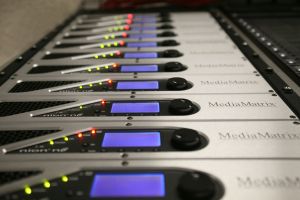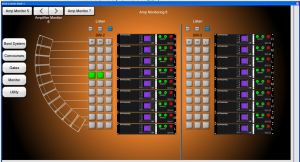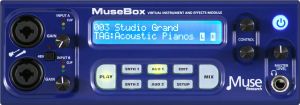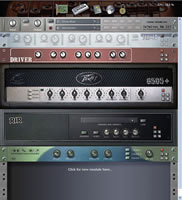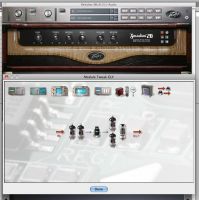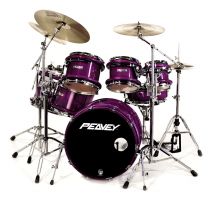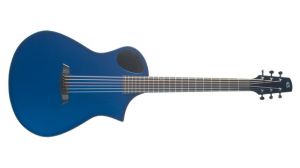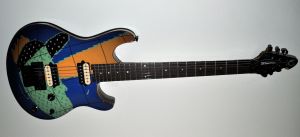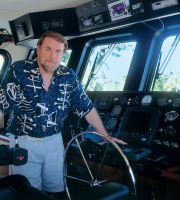www.kvraudio.com/interviews/hartley-peavey---historian-innovator-and-industry-driver---part-2-19422
Hartley Peavey - Historian, Innovator, and Industry Driver - Part 2
20th July 2012
This is the second part of the KVR interview with industry innovator and founder of Peavey Electronics, Hartley Peavey. Part 1 can be found here.
In 1993 Peavey Electronics began marketing MediaMatrix, the first digitally networked audio solution, which has been deployed in such diverse locations as the Beijing International Airport in China, the US Capitol, the Opryland Convention Center in Tennessee, and over a quarter of the NFL stadiums in North America. More recently they have entered the software plug-in market with ReValver and the MuseBox.
What are your thoughts about the impact computers have had on the industry. What about MediaMatrix?
You know, a lot of people think I got my start in the guitar amp business. And technically that's true. But the reality of it is that from about 1968 on, the majority of my business has been building sound systems. So we went out and formed a strategic partnership with a software company to end up with MediaMatrix. We introduced MediaMatrix in 1993 at the AES show in New York City.
A lot of people who should have known better thought it was some kind of a drafting program, where you have all of these little blocks and you essentially glue them together. We said no, you don't understand. This actually passes the sound. And a lot of the contractors said, "I'll never trust my theater designs to a computer." So we loaded up a system in our little company plane and flew all over the country doing presentations to all of these sound designers who had never had a tool like this before. I mean, we were the first, and now we have well over 10,000 installations throughout the world, including the U.S. Senate, the U.S. House of Representatives, the Great Hall of the People in China, the new Bundestag in Berlin.
We started that revolution. But incredibly somehow people still think Peavey is this little non-technical bunch of people out in the sticks in Mississippi. And every time we turn around, we're revolutionizing the way things are done. Harman is in it now and all of these people are doing digital networking that we introduced it in 1993. That's my thing. Since I was a little kid, if the rest of the world is going off in one direction, I tend to wander off in another. To be better...to be the best, you have to be different.
That runs against the approaches most people in the music and the sound business because they tend to want to do that same old thing over and over and over again. But along the way I went to JBL, I went to Altec, all of these people trying to make a loudspeaker that would take the power. They all told me, "Well, your customers don't know how to use precision transducers and blah, blah, blah." And I said, "Yeah, that may be true, but that doesn't change the fact your product is blowing up." So in 1975, I started building my own loudspeakers. Why did I do that? One very simple reason: from the car radio to the largest concert sound system you could imagine, what's the first component that's going to burn out?
Speakers...
Bingo! And that's why we make our own speakers.
ReValver and the MuseBox are another new direction for Peavey. How are you dealing with it from an organizational point of view?
Everybody said that I was crazy, including my wife. She said, "We're a hardware company and you're introducing a software system that will eliminate most of the hardware." And I said, "Yeah, that's right. But if we don't do it, somebody else will." Well, we're kind of learning about that because we have sold software as part of a system, as MediaMatrix, but ReValver is our first expedition into software alone.
First of all, let me tell you why. The reality is, our language, and as far as I know, no language, has the ability to accurately describe a tone. A musician will talk to you in very subjective tones. He'll say, "Well, I want something that's really ballsy on the low end, with a thick, creamy mid-range, and a nice, tight high end." Now what the heck does that mean? It means one thing to that guy. It may mean something totally different to me, and will most likely mean something totally different to you because those are subjective terms. If I say I want something halfway between red and purple, kind of in the middle, kind of magenta, then in your mind you can kind of visualize that color. But when you're talking about tone, you can't do that.
When we work with artists, we have to sit down and play "Guess What They Want." So we'll sit down with a resistor-substitution box and go click-click-click, how about that? Just like when you go into the eye doctor and he puts you behind these things and says, "Alright, which looks better? This or this?".
So I said, "wouldn't it be a great thing if somehow we could come up with a way for a musician to sit down and tweak an amplifier to make it sound just like what he wants it to sound? He doesn't have to worry about going high voltage and he doesn't have to know how to solder. He doesn't have to have resistors and capacitors and know how to hook it all up. Wouldn't it be a wonderful thing if he could sit down and tweak his own and make it sound like anything he wants?" And that's what Revalver does, by the way.
Yeah, ReValver's "Tweak" feature.
Well, ReValver is a tube simulator. You know, some of our competitors have very nice amplifier modeling. But what they do is, okay here's a Marshall. They'll let you turn the treble control up and down, and the middle control up and down, the bass control up and down, and the volume and gain or whatever up and down, and that's it. It's a Marshall and it sounds like this. But what if that's not exactly what you want for your music? They can come pretty close to a Marshall or one of ours. Take your pick. But it's no better than taking the actual amplifier and tweaking the tone controls. With Revalver you can go in and actually engineer the whole amplifier. You can go in and change the value of the plate load resistors. You can change the tube type. You can change tone stacks. You can have an output and it can be single ended or it can be class A or class AB. You can use EL34s. You can use 6L6s and you can use KT88s. I love this stuff.
Note: Some of Hartley's discourse on vacuum tubes and their application in music can be found in Part 1.
Have people gotten pretty creative with it?
Some of them have, and a lot of them haven't because they go in and use the presets. We have presets just like everybody else. But if you're really into it and you really want to tweak the thing, you can sit down and design your own amplifier.HP: Well, it is. There are over 700 guitar speaker simulations in there, from old Jensens to Celestions to any kind of speaker you can think of. And you can take the cabinet and make it big or make it little. You can make it deeper or you can make it wider. You can make it closed-back or you can make it open-back. It is a virtual, infinite palette of tonalities.
To what do you owe Peavey's longevity as a family owned company?
Well, one little thing I tell people that I think is very pertinent and profound is that business is like a rodeo; the winner is the one who stays on the pony the longest. As I look around I don't see anybody that are doing what they've been doing for 47 years. You notice that most of the companies in our industry that have reemerged are taking it back to their beginnings. Fender, for instance, can you name me a successful new guitar that Fender has introduced in the last 40 years? Just one will do....
Hmmm... No.
And the fact is, they haven't. Every time one of these companies falls from grace and some savior comes in, invariably they go back to the same old stuff. And that's what I meant by so many people in our industry are burdened with this "cow path" mentality, but not me. I get into discussions with engineers, and a lot of the time I get a soliloquy about how what I'm asking for can't be done. My advantage is that I'm too stupid to know that something can't be done, so we go ahead and do it.
When I visited Peavey in the early '90s I was really impressed with your manufacturing facility that could be reconfigured very quickly to do different products.
Yeah, well it was all-modular, and that worked very well until China came along.
But at the time, was that innovative for a US MI company. Where did the idea come from?
Well, it just made sense and the guy that thought it up was a guy named William Hatcher. He was a brilliant guy and at that time he was our general manager and he said, "I'm going to design this thing in a modular way so we can change it. Hell, we might be making heart rhythm devices some day, who knows?" So that's the way he set it up.
Were any of the other companies in the industry doing that at the time?
No. See, one of the reasons we can make a better product for less is because we are very vertically integrated. We make our own cabinets. We make our own chassis. We make our own circuit boards. We make all of this stuff, and the reason we do that is because if I was living in Dallas or LA or Seattle or some place, there would've been some place in town that I could've had the chassis made, or had the cabinets made. But in Meridian, Mississippi, there was no place for me to go and get it done so I had to do it myself. We put things together literally from the ground up. We still do our own silk screening. We even make our own speakers. We're the only guitar company in the world that makes its own speakers.
Are there any regrets that you have?
A couple of times we've failed. We failed with the drums. And I still haven't figured that out because we had the best drum in the world. And I failed with keyboards, because I couldn't make any money at it. Our idea with the keyboards was to do it with an off-the-shelf DSP, the 56000 from Motorola, and we made a software-based synthesizer, three of those, and our idea was we were going to sell the keyboard at about cost. We were going to make our money on selling the sounds. We didn't plan on a little company up east called Ensoniq giving away the sounds. And I never could figure out how they were doing that, because sounds are very expensive to come up with, as you know. And it turns out they couldn't do it either and they eventually went bust, but not before pissing in my punch. So those are the two that we failed on.
Well that's not a bad record. What's next?
Our Composite Acoustics carbon-fiber guitars, they really do sound better than wooden guitars. We've had to learn a whole different thing because making these guitars is more like baking a tray of cookies than it is making a wooden guitar. You mix it up, you pour it up, you line it in a mold and you put it in the oven. And when it comes out, it's done. And learning how to make the secret sauce has been quite an enterprise over the last year and a half. But when people play it they say, "Man, I can't believe this." We're using stainless steel frets. There's no wood in the guitar. The fretboard is composite. The body of the guitar is carbon graphite, and it's just more resonant than a wooden guitar.
I'll be curious to check them out.
Look under CAguitars.com. We've got about four models. We have a little travel guitar called a Cargo that's just about as cute as it can be. We're about to do an ad on it, but I'm afraid to do an ad until I get my production up, of a guy sitting in a canoe using the guitar as a boat paddle. And you can literally do that, by the way.
That's pretty amazing. I don't think I'd want to...
If you did that with a wooden guitar, you'd be up the creek without a paddle. We don't have a truss rod because we don't need one. The neck doesn't move like it does with a wooden guitar, with changes in temperature and changes in humidity. So that's the latest different thing that we're doing.
Hartley Peavey makes the musical instrument industry a more interesting place and he has built a successful company by working hard to lower his costs so that lower costs can be passed through to his customers without sacrificing quality.
Once again, Part 1 can be found here.
KVR Audio, Inc.
www.kvraudio.com
